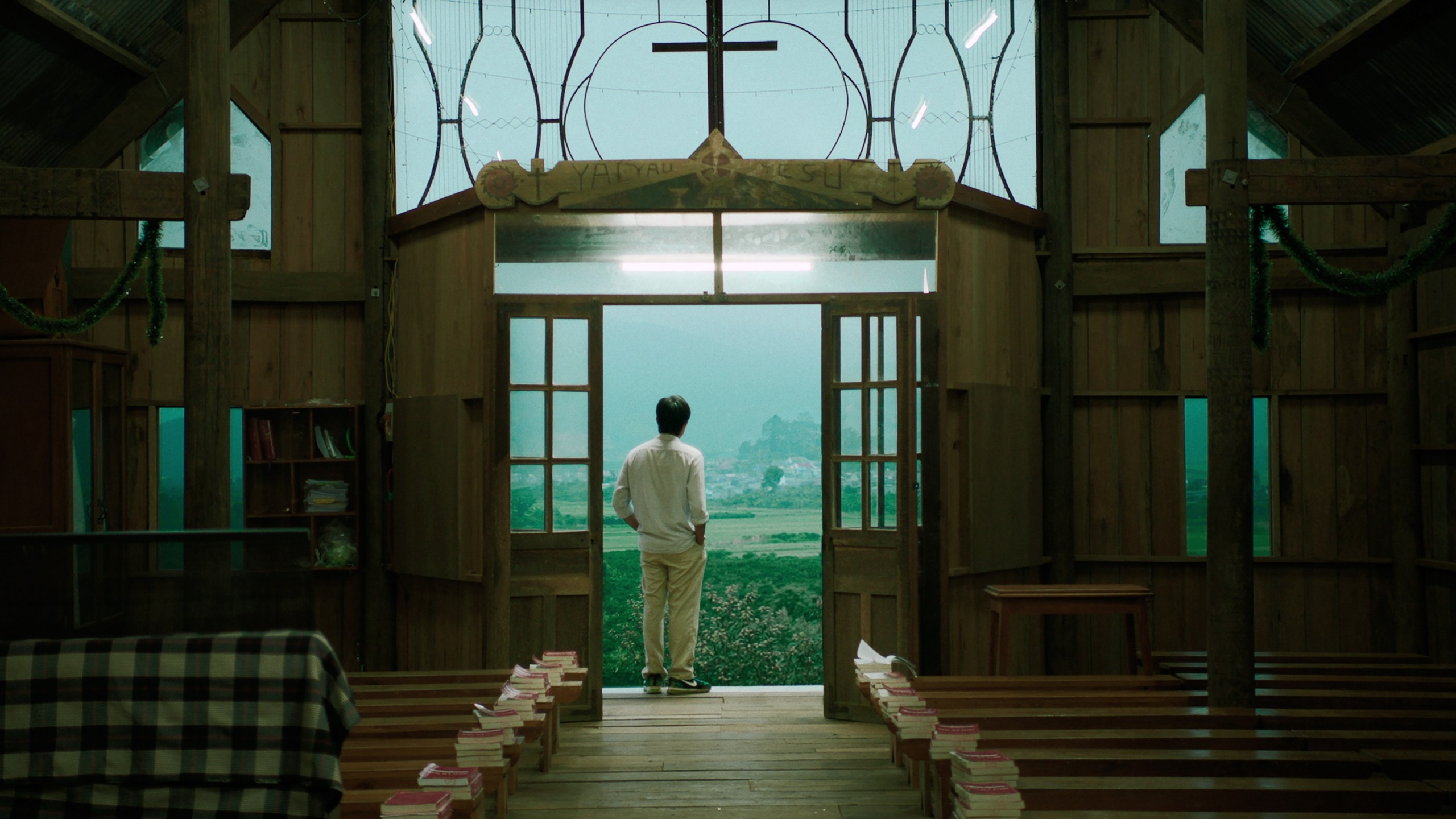
Editor’s note: This review was originally published at the 2023 Cannes Film Festival. Kino Lorber releases the film in theaters on Friday, January 19.
An intimate three-hour epic of deliberate pacing, Vietnamese writer-director Thien An Pham’s debut feature, “Inside the Yellow Cocoon Shell,” is a spellbinding tale of the soul’s unfathomable desire for the other-worldly, that does itself border on transcendental in its filmmaking and gradual blurring of apparent truth and suggested fantasy.
The film premiered in the Cannes’ Directors’ Fortnight section, where the filmmaker was previously recipient of the Illy Prize in 2019 for the short “Stay Awake, Be Ready,” in which a roadside accident at a street corner interrupted a conversation between three friends having a meal. That short seems loosely remade for the new feature’s opening scene, which expands the idea to explore a man’s attempted overcoming of a deeply unsatisfied life, taking him from urban Saigon to the hinterland of Vietnam, out of both familial necessity and a quest to make sense of where and how to proceed with his life going forward.
“Inside the Yellow Cocoon Shell” opens on a static shot of someone in a mascot costume lingering outside of where a football (soccer) game is taking place in Saigon. The camera then tracks this brief subject of our focus to an outdoor bar to the side of the grounds, where three sitting companions turn down the costumed figure’s attempts at engagement. One of the men expresses considerable skepticism concerning his friend’s discussion of his faith and the ease with which he’s able to believe in a higher power. The third man of the group, the film’s thirtysomething protagonist Thien (Le Phong Vu), eventually chimes in with his thoughts when prompted: “The embrace of faith is ambiguous… I want to believe but I can’t. I’ve tried searching for it many times, but my mind always holds me back.”
Thien’s about to be nudged towards properly grappling with notions of fate and the spiritual, though he has a delayed response to engaging with the information that will set this in motion. Approximately five minutes into the film’s running time, Thien and his friends’ discussion is interrupted by the sound of a nearby collision. Just beyond the outdoor bar’s premises, a crash between two motorcycles has taken place. Suggesting both general apathy and such accidents being commonplace, nearby observers are slow to actually approach the three injured or potentially dead bodies strewn on the road, while Thien is among those who just stay put in their seat.
Cut to Thien and friends at a spa later that night, where he repeatedly ignores phone calls. When in a room for a private back massage, the masseuse asks if he’s afraid to pick up his vibrating cell phone because it might be his girlfriend, to which he responds that “God is calling,” then referring to the deity as his “client.” Shortly after, the masseuse takes a cue from his sardonic comments when he looks to be adjusting his position while lying on his stomach. “Is God stuck? Let me help you,” she says, before reaching for his crotch for suggested tugging of that area’s contents.
It’s during this moment that Thien is finally forced to deal with the freak occurrence that propels his journey going forward, as another spa employee enters and interrupts to say that one of Thien’s friends insists he absolutely needs to answer his phone immediately. It turns out his sister-in-law, Hanh, was killed in the earlier motorcycle accident that Thien ignored, while his five-year-old nephew, Dhao (Nguyen Thinh), was (miraculously) largely unharmed despite also being thrown from his mother’s vehicle.
Thien, who works in Saigon as a video editor and has been fairly estranged from his family, is now Dhao’s only living relative there, and so he goes to the hospital to meet the boy and take care of all necessary procedures in order to transport Hanh’s body back to their hometown. Within the purse among her recovered belongings is a picture of Hanh with Thien’s older brother, Tam, who vanished years ago. There are differing stories regarding Tam’s absence scattered across the film. One is that he left his wife and son for another woman. Another is that he may have found a spiritual calling that required abandoning his family with no explanation. Either way, Dhao now needs a guardian, whether it’s his real father or not.

Traveling across Vietnam to his former countryside hometown, Thien is present for the Christian funeral for Hanh. The proceedings, which include processions at both night and in daylight, are seemingly staggered over a number of days, with Thien sticking around for roughly a week to pray for her soul with relatives, including Hanh’s brother, Trung (Vu Ngoc Manh). He spends time with Dhao too, who at one point asks him what “faith” means. For the child, the agnostic man compares faith to being sure that a friend will return a toy which you have let them borrow.
Pham and his DOP, Dinh Duy Hung, favor long takes throughout the film. While some of these are static and wide angle, many gradually morph within a given sequence playing out in real-time; following a character elsewhere outside of the initial viewpoint, accompanying them on a journey to another destination before they and the camera then stay still for another little while. Never coming across like a spinning of wheels, the leisurely rhythms serve to let the images, accompanying sounds and natural serenity of the landscapes, farmlands, and city and village spaces — largely shot in natural light — become more deeply absorbed by the viewer.
It’s the kind of film that steadily trains you in perceiving and eventually becoming lost in its sense of time, to the extent that you can almost forget the presence of the camera even when it is moving. You’re living in the frame with Thien; the timing of the camera and character naturally intertwined.
Thien ultimately settles on a plan to search for his missing older brother, though before his mystical pilgrimage begins, there’s something of a road movie quality even to the scenes within the hometown’s borders. The film’s showiest sustained take begins with a long-held static shot lasting several minutes, as an outdoor conversation with Trung takes place, with the camera then following behind Thien and Dhao as they slowly journey on a motorcycle further into town, to pass on payment, on behalf of Trung, to a man who provided a burial shroud for Hanh.
Once they arrive, the camera stays put outside a house without any apparent cuts, as Thien enters the home of the old man, Mr. Luu, and has a long conversation that turns into discussion of Mr. Luu’s memories of military service, injuries, police work, and how he decided to dedicate the remainder of his life to shrouding the deceased. With the conversation starting by an open window, the camera almost imperceptibly moves closer and closer from outside and into the kitchen space within the house. By the time there’s finally a clear cut, it’s been nearly 25 minutes since the sequence began with Thien talking to Trung in a different part of town. That Mr. Luu is reportedly a non-professional actor and real local of the area, regaling stories of his own life (though rehearsed so as to avoid any incoherent tangents), makes the magic trick of the lengthy sequence even more impressive.
Thien has many more meaningful encounters on the road, but it’s a specific reconnection with his painful past that’s the basis for the film’s most beautifully moving sequence, wherein the film’s flirtations with the surreal escape the confines of more explicitly designated dream sequences. Stopping off at an abandoned building and heading to the roof, Thien seem to be getting followed by a mysterious, barefoot young woman glimpsed through window spaces to the side of the frame. Up on the roof, he suddenly engages in conversation with the figure who’s approached.
It’s Sister Thao (Nguyen Thi Truc Quynh), a nun introduced earlier, who was once Thien’s girlfriend in the time before he moved to Saigon for work. The conversation they engage in on this puddle-populated rooftop is one they had many years earlier, but this is not a flashback in the traditional sense. While Thao is (initially) bubblier and styled so as to code her as her younger self, before she gave herself to God, Thien looks the same as he has for the rest of the film, and is wearing the same clothes he will continue to travel in beyond this scene. His memory of this event is represented by two timelines intertwined within the same physical space; she looks as he remembers when this conversation happened years ago (a ghost Thien can still touch and kiss), while he is how he currently is in the present timeline.
Thien’s reunion with a lost love apparently able to resolve her once consistent malaise through faith is one of several key explorations of divine calling throughout the film. And connecting with the movie, getting on its wavelength, is not reliant on one having had their own direct experiences with religious faith from which to draw. Whether or not you’ve ever believed in a higher power, we’ve all questioned who we are, what we’re living for, and how to escape a certain mundanity in which modern society can box us. Based on the quality of his debut feature, Pham has certainly found his own divine calling with filmmaking.
Grade: B+
“Inside the Yellow Cocoon Shell” premiered at the 2023 Cannes Film Festival.




